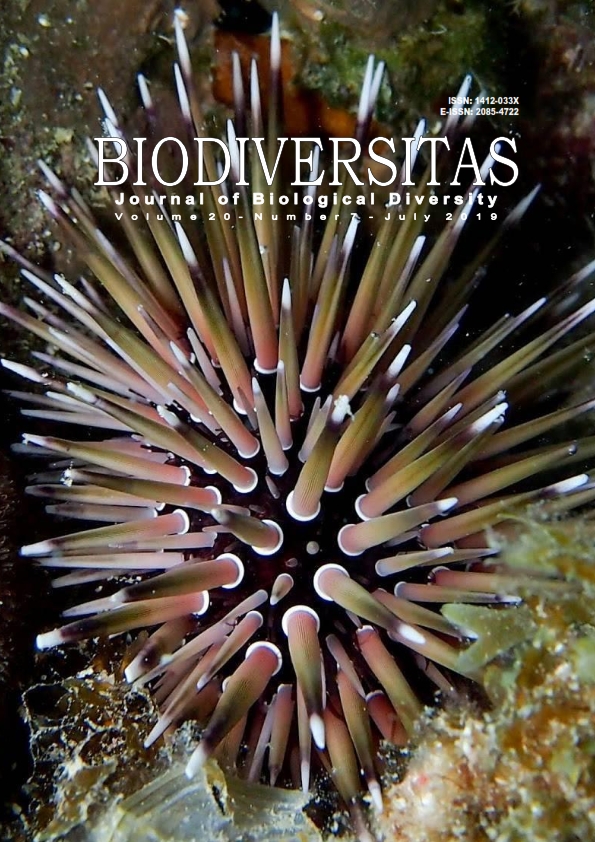Rangeland conversion to dryland and its effects on species diversity and richness
##plugins.themes.bootstrap3.article.main##
Abstract
Abstract. Hasanpori R, Sepehry A, Barani H. 2019. Rangeland conversion to dryland and its effects on species diversity and richness. Biodiversitas 20: 2043-2047. Species diversity and richness status in ecosystem is important in confront to environmental threats and is guidance in plant management. Due to increasing land use changes and destruction of rangelands in western Iran, this research was conducted to study the effects of land use change from rangeland to dryland on species diversity and richness of vegetation cover in three land uses of rangeland, dryland and abandoned dryland. Vegetation cover data were collected from established plots in each land use. Species diversity and richness were calculated in each land use by Simpson and Shannon indices and Menhinick and Margalef ones, respectively. Results showed that these indices are significantly different at 95% level in three land uses. The highest species diversity and richness indices were in rangeland and the least were in dryland. So, we found that four above measured indices, are illustrative and accurate enough to demonstrate differences between several land-use diversity and richness. Simplification on a dynamic and diverse ecosystem, and land conversion to dryland reduced plant species numbers in the new ecosystem, and simplify species composition, so simple dryland ecosystem would be fragile against environmental threats. Therefore to reduce unfavorable effects of land use changing, paying more attention to species diversity conservation must be a base to management decisions.
##plugins.themes.bootstrap3.article.details##
Assareh MH, 2001. Iran biodiversity flora. Research Institute of Forests and Rangelands.
Austin MP, Nicholls AO, Doherty MD, Meyers JA, 1994. Determining species response functions to an environmental gradient by means of a ?-function. Journal of Vegetation Science 5 (2): 215-228.
Cain SA, 1938. The species–area curve. American Midland Naturalists 19: 573-581.
Eghdami H, Tarkesh M, Basiri M, Iravani M, Mohajeri A, 2012. Changes in indices of species diversity and richness of good, degraded rangelands and abandoned dry lands in Fereydan, Isfahan. Journal of rangeland 2: 100-109.
Eloun H, Ghorbani J, Shokri M, Jafarian Z, 2007. Vegetation composition in two rangelands and adjacent cultivated lands in a Part of Tangab Dam sub basin in Firozabad at Fars Province. Journal of rangeland 4: 370-385.
Enright NJ, Miller BP, Akhter R, 2005. Desert vegetation and vegetation-environment relationships in Kithara National Park, Sindh. Journal of Arid Environment 61: 397-418.
Goodman D, 1975. The theory of diversity-stability relations in ecology. Quarterly review of biology 50: 237-266.
Grebner DL, Bettinger P, Siry JP, 2013. Introduction to forestry and natural resources. (1st edition), Academic press.
Hammer O, 2018. PAleontological STatistics (PAST), Version 3.20, Reference manual.
Johansson LJ, Hall K, Prentice HC, Ihse M, Reitalu T, Sykes MT, Kindstromc M, 2008. Semi-natural grassland continuity, long-term land-use change and plant species richness in an agricultural landscape on Oland, Sweden. Landscape and Urban Planning 84 (3-4): 200-211.
May RM, 1975. Patterns of species abundance and diversity. In: Cody, M.L. and Diamond, M.L. (Eds.), Ecology and evolution of communities Harvard university press, Cambridge.
Mclaughlin A, Minear P, 1995. The Impact of Agricultural Practices on Biodiversity. Agriculture, Ecosystem and Environment 55:210-212.
Palmer MW, Maurer TA, 1997. Does diversity beget diversity? A case study of crops and weeds. Journal of Vegetation Science 8: 235-240.
Rahimidehcheraghi M, Erfanzadeh R, Joneidi Jafari H, 2013. Effect of land use change on plant species diversity, richness and evenness (Case study: A part of Kamyaran rangelands). The second national conference of planning, protecting and Conserving Environment.
Rahmani H, Asri Y, Ramezani M, Khorasani N, Maroofi H, 2016. Effects of rangeland land use changing into dryland from herbal species diversity viewpoint (Case study: Rangelands in Dehgolan city, Kurdistan). Journal of environmental science and technology, 18(2): 433-444.
Takehiro S, Satoru O, Tomoo O, Unddarmaa J, Toshiya O, Kazuhiko T, 2011. Indicator species and functional groups as predictors of proximity to ecological thresholds in Mongolian rangelands. Plant Ecology 212: 327-342.
Van der Maarel E, 2005. Vegetation ecology. Blackwell publishing.
Vogt KA, Gordon JG, Wargo JP, Vogt DL, Asbjornsen H, Palmiotto PA, Clarck HJ, Ohara JL, Keeton WS, Weynand TP, Witten E, 1997. Ecosystems: Balancing science with management, New York.
Yuguang B, Abouguendia Z, Redmann RE, 2001. Relationship between plant species diversity and grassland condition. Journal of range management 54: 177-183.
